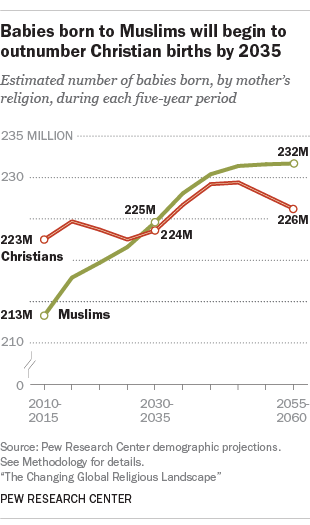Muslims are on track to become the world’s fastest-growing major religious group in the years ahead, according to a new analysis of data from the Pew Research Center.
Christians make up the largest religious group in the world, at 2.3 billion people. Muslims make up the next biggest group, at just under 2 billion. But the global Muslim population is relatively young, with a high fertility rate and a low death rate.
In an analysis released Wednesday, Pew estimates that in the five-year period between 2030 and 2035, the Muslim birth rate will overtake the birth rate among Christians, with 225 million babies born to Muslim families in those years, compared to 224 million among Christians.
From that point, the birth gap is only expected to increase. Between 2055 and 2060, Pew estimates, there will be 232 million births among Muslims compared to 226 million births among Christians.

The total Christian population will still be larger well into the century, and it will continue to grow rapidly in some regions, like sub-Saharan Africa. But, Pew notes, “the same cannot be said for Christian populations everywhere.”
In recent years, Christians have accounted for roughly 37 percent of the world’s deaths ― largely due to the advanced age of Christian populations in some parts of the world.
“This is especially true in Europe, where the number of deaths already is estimated to exceed the number of births among Christians,” Pew notes. “In Germany alone, for example, there were an estimated 1.4 million more Christian deaths than births between 2010 and 2015, a pattern that is expected to continue across much of Europe in the decades ahead.”
By the final decades of the 21st century, Pew predicts, there will be more Muslims than Christians in the world.

Meanwhile, the world’s share of people who are religiously unaffiliated is expected to drop.
The “nones,” as they’re called, currently make up 16 percent of the global population. Their numbers will continue to rise, according to projections, but they will account for a smaller and smaller percentage of the overall population.
This is partly due to the nones’ low birth rate compared to those of other groups. Between 2010 and 2015, only an estimated 10 percent of the world’s babies were born to religiously unaffiliated mothers.

Pew notes that the data doesn’t assume babies will remain affiliated with their parents’ faith once they grow up. In the U.S., the religiously unaffiliated account for nearly a quarter of all Americans, making them the second largest “religious” group in the country. A key factor in their growth is what Pew refers to as “religious switching.” As of 2015, 18 percent of American adults were raised in a religion and later became unaffiliated, compared with just 4 percent who moved in the opposite direction.
Changing religions is fairly common in the U.S., but it can be rare, dangerous or even illegal to do so in some other countries.

